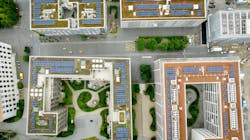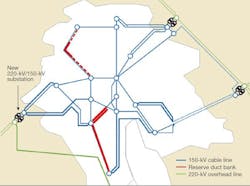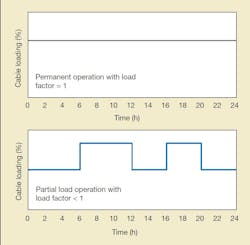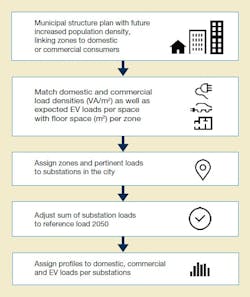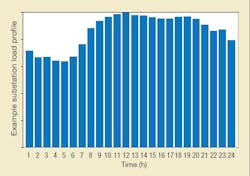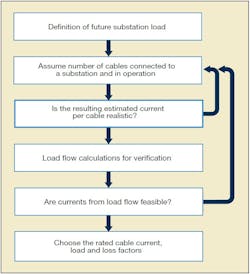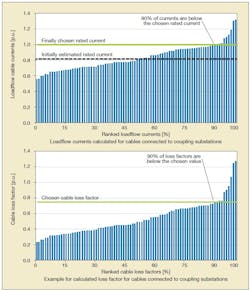Switzerland's Largest City Plans 2050 Target Grid
As the distribution system operator for Zurich, Switzerland, ewz is developing its 150-kV grid to meet estimated demand in 2050. This grid of the future must also meet ambitious goals the city of Zurich has set for energy efficiency, sustainability and reduction of carbon emissions. To reach these goals, renewable energy (mainly photovoltaic systems), electric vehicles (EVs) and electric heat pumps have been identified as important focus areas. As the distribution system operator, ewz must provide the necessary infrastructure.
Additionally, a major change is planned for the network topology of Zurich’s 150-kV distribution grid. Today, four coupling substations connect the 150-kV grid to the national 220-kV grid. Two of the stations are in the south, far outside the city of Zurich. From these, energy is transmitted through the 150-kV lines to the city. A new 220-kV/150-kV coupling substation right at the border of Zurich will replace them. The type and number of cables connecting this new coupling substation to the city must be planned.
Regulations regarding magnetic field emissions are strict in Switzerland. Therefore, ewz decided the cable type for its future high-voltage grid must be changed. Instead of single-core cables, three-core cables will be used because they do not require additional shielding. To make this change, ewz had to define completely new cable requirements that would be suitable for several decades, handling power flows today and well into the future.
Maximum Cable Current
One aim was to achieve a rated cable current as high as possible with a given conductor diameter. Thus, cable load and loss factors — both derived from load profiles — were used. The load factor is the ratio of the average current per day to the maximum current. The loss factor includes thermal inertia.
2050 Expected Demand
As electrical supply must be available in all conditions, the maximum load or production case was used for planning purposes. In Zurich, the maximum demand occurs during a cold and cloudy winter period, including high demand from electric heat pumps and electric vehicles but nearly no production from photovoltaics.
To estimate the city load in 2050, ewz used various scenarios with expected consumption and production for the future. The scenarios included a substantial load rise from increases in population, building density in the city and electric vehicles becoming 90% of vehicles on the road by 2050.
Thanks to Zurich’s municipal structure plan, ewz was able to evaluate the effects of an increased population. The city is divided into building zones, and the municipal structure plan determines the maximum building floor space for each zone. With the planned increase in building density, the maximum floor space of buildings also is expected to rise. The potential for city load growth is in the zones where the maximum allowed floor space has not been realised yet.
Furthermore, the municipal structure plan assigns domestic and commercial building utilization to the zones. For both purposes, load densities (volts-ampere/sq m) were defined and assigned to the building floor spaces of the zones (sq m). As a result, ewz was able to aggregate the load for domestic and commercial purposes for each zone. The expected EV loadings, with load management, were added to these zone loads. The final zone loads were assigned to the city substations.
To establish substation load profiles, the domestic, commercial and EV loads were aggregated proportionately with corresponding profiles. Considering EV load management, ewz estimated a proportion of EV charging would be shifted into the night.
Planning Requirements
To determine the critical cable loadings, planning requirements were established. Emphasis was put on outage conditions, during which the security of supply should still be guaranteed. These conditions strongly depend on the topology of the grid.
For the city of Zürich, high-voltage cables were separated into two groups and different planning requirements were applied:
- 150-kV cables connecting a coupling substation to the substations in the city — As these cables supply the city, they needed a high-rated current. Even if one of the connecting cables were to go out of service, the coupling substation should still feed its assigned load.
- 150-kV cables within the city, linking the substations — As this part of the grid is meshed, these cables transport less energy and require a lower-rated current. If any cable were to fail, the grid should remain in operation and stay within the cable capacity limits. In Zurich, because of frequent urban construction, several cables at a time often must be put out of service to ensure safety. Depending on the location of construction sites and taking into consideration the possible outage of a cable, the worst-case condition is one cable supplies a substation.
According to the planning requirements, the number of cables connected to a substation was assumed:
- For the new 220-kV/150-kV coupling substation, the number of cables in operation and the maximum coupling transformer power provided an estimated cable current. The number of cables was adjusted to make sure this cable current would be available.
- For the substations in the city, it was determined in the planning requirements that one cable in operation should be capable of feeding the maximum
expected substation load — thus resulting in an estimated cable current (which was lower than that of the coupling substation).
These estimated currents were verified with load flow simulations.
Load Flow Simulations
Load flow simulations for 24-hr profiles were performed according to the planning requirements. To switch the cables off and on for calculations, the load flow software was controlled by a script. The simulations for each cable in 24 hourly currents per day resulted in about several thousands of values in total.
Again, it was the aim that rated current would be available and realistic. The final cable rating was chosen in a way that 90% of the currents from load flow calculations were smaller or equal. For the last 10% of load flow calculation currents above the chosen rated currents, it was decided additional measures would be investigated. For the meshed cables within the city, the load flow simulation resulted in a current distribution below or equal to the estimated current. Therefore, it was defined as the rated current for these cables.
When analyzing the hourly currents for the cables within the city, no violations of the chosen rating were found.
The Target Grid
For 150-kV cables connected to the new coupling substation, which have different cable types and lengths, it became clear to ewz that load flow simulations were essential to perform because of the highly uneven current distributions. Thanks to the cable load and loss factors, determined from the hourly time simulations, a higher cable ampacity was achieved.
Klaudia Madeira Bein ([email protected]) has a MSEE degree from the University of Karlsruhe. From 1994 to 2016, she worked as an electrical engineer for power plant system engineering at ABB, Alstom and GE in Switzerland. In 2016, she joined ewz, the distribution system operator of the city of Zurich. She is a senior specialist for grid development, and her responsibilities include the future 150-kV target grid.
Britta Heimbach ([email protected]) holds a MSEE degree from RWTH Aachen University, a PhD degree from Ruhr University of Bochum and a MBA degree in business administration. She has worked as a specialist for grid planning and asset management at RWE Energy in Germany from 1993 to 2008. Since 2008, she has been with ewz in Switzerland and currently heads grid development.
Juerg Dieter Bader, PhD, studied mathematics and physics at ETH Zurich. He was with ewz from 1995 to 2023, focusing on grid concepts and development. His responsibilities included statistical models for long-term forecasting of electric power demand and renewable energy sources.
Andri J. Casura ([email protected]) gained a MSEE degree and a master’s degree in information technology from ETH Zurich. After dabbling a few years in protection, automation and project management, he achieved a master’s degree in management, technology and economics also at ETH Zurich. In 2015, Casura was appointed to the newly formed high-voltage division, which he leads into the future as a visionary.
Raffael La Fauci ([email protected]) has a MSEE degree and PhD degree in electrical engineering from ETH Zurich. He leads the grid concepts and development department at ewz, the distribution system operator for the city of Zurich, Switzerland.
